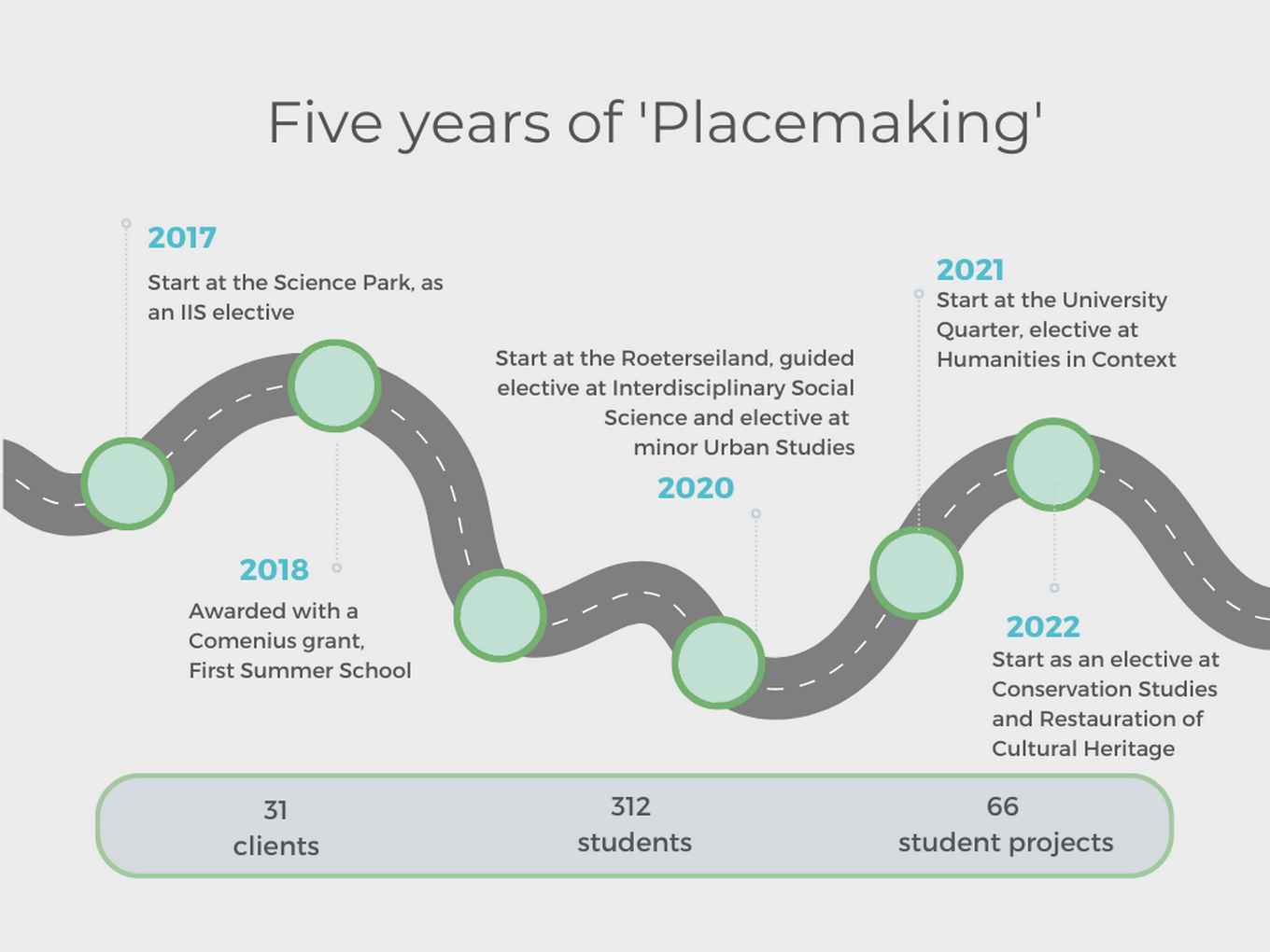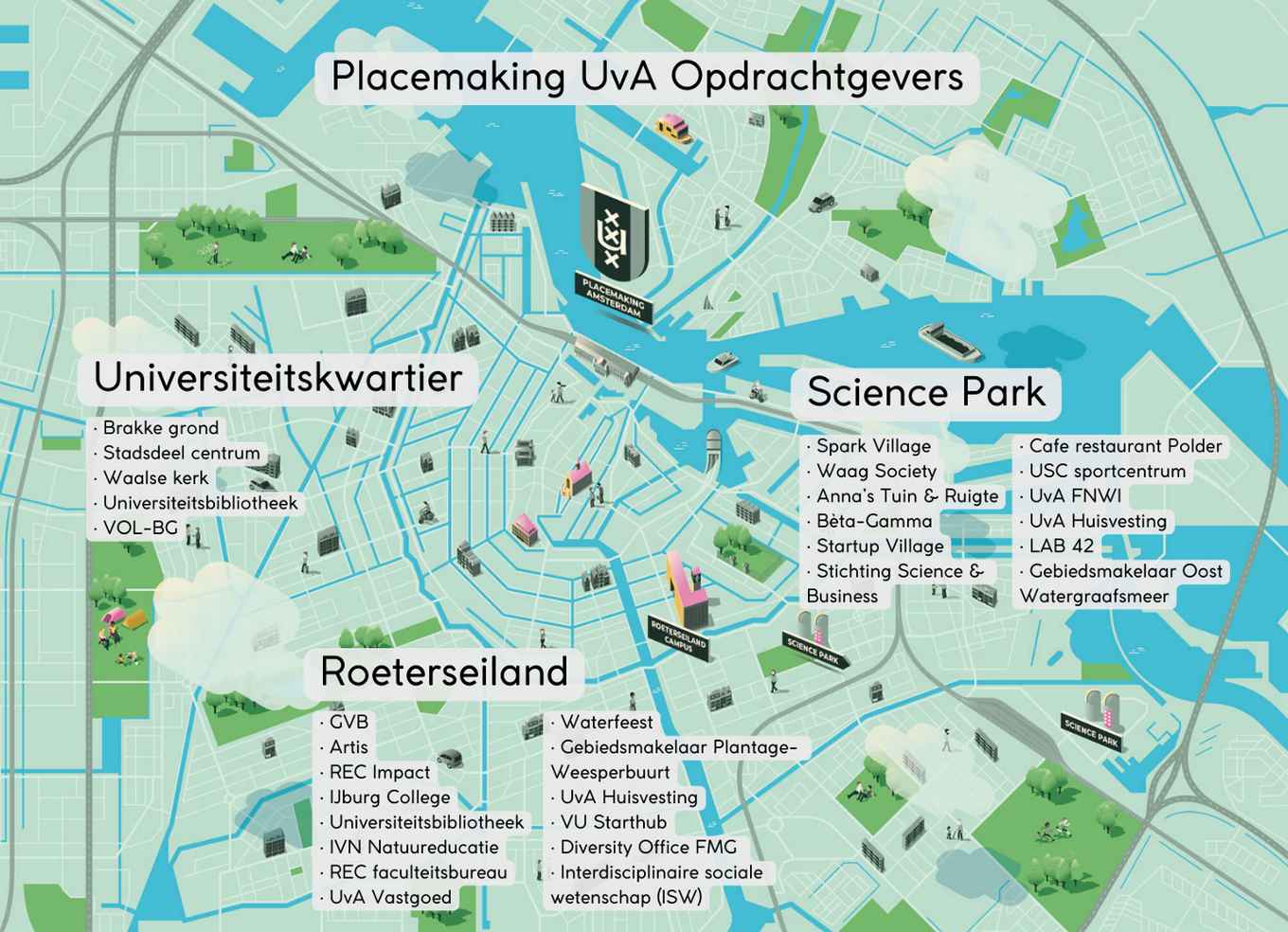Five years of 'Placemaking' at the UvA
Clients reflect upon their experiences
14 september 2022
In more than half of the cases, their initiative is followed up in the area itself, for example by the client or a new group of students. For example, the issue from Anna's Garden and Ruigte, a community garden near the Science Park, was how to establish sustainable partnerships with the environment. Placemaking students co-created a teaching package for elementary schools in district East in Anna's Garden and Ruigte by UvA biology students1. The teaching package is now offered through the UvA.
The fifth anniversary of Placemaking at the UvA provides an opportunity to look at what the education initiative has achieved. In this article, we look at the education initiative Placemaking and what it contributes to the place and the - often complex - issues here among local users and organisations. We include the client's experiences in how places have evolved. In the second article, we focus on the learning outcomes of the students themselves.

Placemaking as a methodology
Placemaking is a philosophy and methodology developed in architecture, planning, and environmental psychology in the 1960s. The basic principle is that places are designed based on local knowledge and local qualities, with the (end) user at the centre. The process of placemaking gives meaning to a place by connecting the community (more) with the place.
The method of placemaking is to involve the people who live, work, and play in a given community by listening to them and observing the place. Through site research, you discover needs and aspirations (1). You then use this information to sharpen the issue and create a shared vision for the place (2), from which you generate different ideas - preferably together with the users of the place(s). You translate this into a so-called 'intervention', a design or programming for a place, which you implement on a small scale (3). You then research and test how the intervention works in practice, and transfer it to the neighbourhood (4)2.
Understanding and involving the local community not only leads to higher quality and better use of public space but also has social consequences such as networking between local residents and a greater sense of ownership of the living environment3. Placemaking thus constitutes an important means of empowerment4.

Placemaking as an elective
In 2017, the Institute for Interdisciplinary Studies (IIS) at the UvA turned the philosophy and methodology of placemaking into an elective course focused on linking theory, policy, and implementation of Placemaking. Students learn to interact with the (social) environment by immersing themselves in their campus area. Within this course, students work transdisciplinary with a client on a social place-based challenge, where aspects of urban development such as participation, design principles, ecological principles, and administrative-legal frameworks form starting points for analysis and transformation. Based on research, students initiate - in co-creation with key stakeholders - an on-site intervention, exploring how it can contribute to improving the area. Placemaking also has an estafette element: students from several generations often work for the same client(s), using knowledge and insights from the previous group. In this way, students build on the relevant area file.
What does Placemaking bring to the location?
To answer the question 'what does Placemaking deliver', we conducted interviews with several stakeholders and distributed a questionnaire to over 30 Placemaking clients5. We questioned their experiences, insights, and the effects they think the placemaking method has had for the place. All respondents called the greatest added value of Placemaking 'instructive', in the sense that it has provided insights into the issue, the method, and into the outcome. Moreover, organisations recognise the importance of Placemaking for students themselves. Suzanne Brinkman (Artis): I find the method and approach refreshing and fully support the idea of giving university students more hands-on experience at organisations in this way.
Moreover, more than half of the respondents feel that Placemaking has provided insights into the way his/her organisation works. For instance, clients indicate that it helps to underpin the choices they make. For Jasper ter Schegget (programme director of Bèta-gamma), for instance, it has had the following effect: (Putting) a problem/question on the agenda in one's organisation and conversations about the subject in which one is forced to sharpen one's thoughts and in which one receives valuable feedback. More than half also feel that Placemaking adds value to the place/assignment students have worked on. Marieke Brand of the Stichting Waterfeest said: Great things have come out of the students' work, which we are still working with today. About a third of the clients feel that Placemaking has provided insights into their working methods. Sofie Rouw (UvA Library): Not so much for my working method, but for some of the assumptions I make. Commissioning placemaking has brought me even closer to students' perceptions.

'Sustainability' was also mentioned as an added value by more than half of the respondents. At nine (out of 16) clients, the issue was followed up, either by a subsequent group of students, by the client itself, or by another party involved. For example, students with Plan B(ee) devised an intervention that contributes to making the Roeterseiland campus nature-inclusive. By placing water gardens in the canal, containing plants attractive to insects and water-purifying plants from below. Remarkably, students included not only users of the campus, such as students and residents, but also nature as a stakeholder in their analysis. The client UvA Vastgoed is now working on realising Plan Be(e).
The assignment from area broker city district Oost-Watergraafsmeer was also followed up. The students' request was to improve the playing facilities on MacGillavrylaan, next to Science Park, based on the wishes of the users themselves - children from the area. Through the placemaking research and intervention, this project was put on the internal agenda and Stadsdeel Amsterdam Oost released budget for implementation. Due to management and other practical constraints, the play area was realised in a somewhat different form - a multifunctional football pitch - but still with the intended purpose: to improve the play opportunities from the needs of its users. The nice thing is, you start with placemaking and let the students in on it. And that something structurally improves as a result, an existing playground that has been greatly upgraded and is now also much better used, says Fred Scheepmaker (area broker Stadsdeel Oost/Watergraafsmeer).
Clients identify opportunities for improvement in implementation. The unprejudiced view of students is both an added value and a pitfall. For instance, clients indicate that it can be difficult - especially within larger institutions - to actually get things done, even if the students' plan is so attractive. Pauline Eenhoorn, (LAB 42): Unfortunately, a few times it turned out that there were no resources available for real implementation of the ideas, or that the ideas were so complicated to implement that it foundered on organisational obstacles. In addition, an intervention, or the prototype is part of the course, and not the follow-up. Some clients expressed their regret that follow-ups were not done (in the short term). Doris Zijlema (Vlaams Cultuurhuis de Brakke Grond): We are happy to continue with the follow-up, as said; good plans, now the implementation.
The physical environment determines how people behave, move, and feel involved. Because Placemaking is a transdisciplinary collaboration, students make a valuable contribution to (the development of) a place. Sofie Rouw (UvA Library): I think it is one of the best integral collaborations within the University. The City of Amsterdam is so pleased with the impact of Placemaking at neighbourhood level that an internship opportunity has been created for a student applying the Placemaking method as of September 2022.
References
1You can read more about this project on the Placemaking website: https://placemakingamsterdam.nl/studentenprojecten/annas-tuin-en-ruigte/financiele-duurzaamheid
2Placemaking cirkel, stichting Placemakers 2013
3Silberberg, S. (2013) Places in the Making: How placemaking builds places and communities. Report by the Department of Urban Studies and Planning (DUSP) of the Massachusetts Institute of Technology (MIT)
4Mateo-Babiano & Kelum Palipane (2020), Placemaking Sandbox, Palgrave Macmillan.
5N=16
This article is part of a diptych. A second article will appear in early 2023 which will focus more on the student perspective.
Authors article: Katusha Sol en Rosanne van Wieringen.